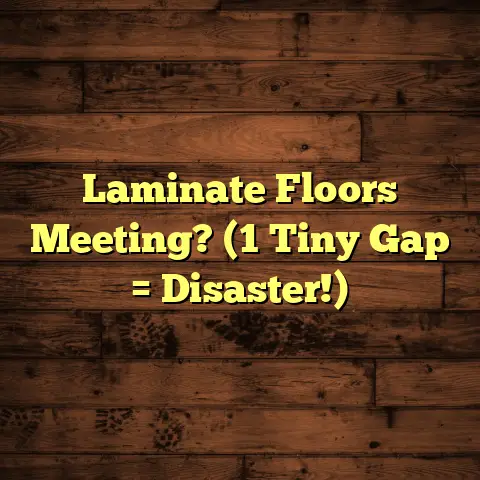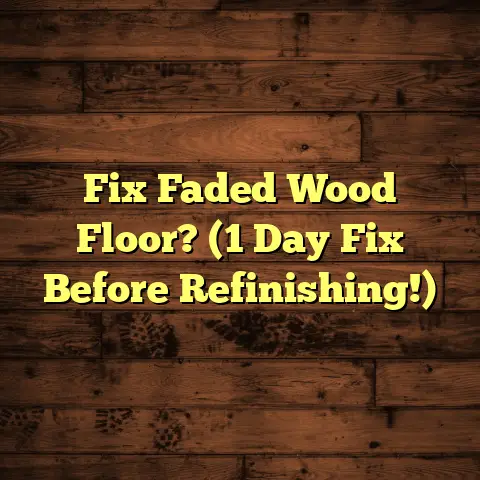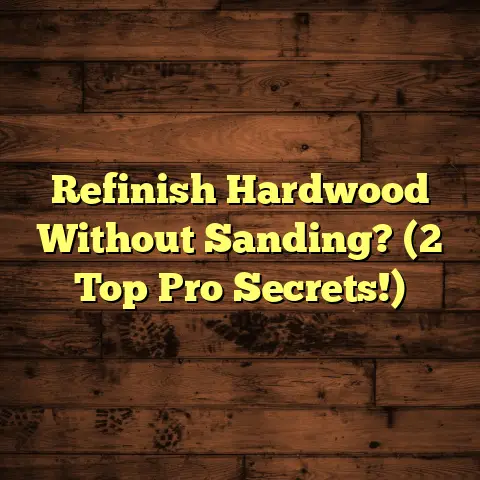Can Rubber Flooring Be Used Outside? (Explained)
I often hear from clients concerned about whether rubber flooring can be used outside.
It’s a common complaint, especially when they want to enhance their outdoor spaces with something durable yet stylish.
Many home and business owners are curious if rubber flooring can withstand the elements.
Can Rubber Flooring Be Used Outside?
Let’s break it down.
I’ve had my fair share of experiences with rubber flooring in various projects, and I can say that it can indeed be used outdoors, but there are several factors to consider.
Understanding Rubber Flooring
Rubber flooring is crafted from natural or synthetic rubber.
It’s commonly used indoors due to its durability, slip resistance, and shock-absorbing qualities.
But when it comes to outdoor applications, things get a bit more intricate.
Types of Rubber Flooring for Outdoor Use
- Natural Rubber: This type is biodegradable and eco-friendly but may not hold up well under harsh weather conditions.
- Synthetic Rubber: Made from petroleum products, this type is generally more durable and resistant to moisture, UV rays, and extreme temperatures.
This is what I typically recommend for outdoor installations. - Interlocking Tiles: These are often used for outdoor spaces like patios or decks.
They provide flexibility in design and easy installation. - Rolls: Rubber rolls can be installed in larger areas like playgrounds or gym spaces outside.
My Experiences with Outdoor Rubber Flooring
In one of my recent projects, a client wanted to transform their backyard into a family-friendly area with a rubber surface.
The goal was to create a safe place for kids to play while ensuring the adults had a comfortable spot to lounge.
I opted for synthetic rubber interlocking tiles, which made installation straightforward and allowed for easy repairs if needed.
These tiles are about 1 inch thick and provide excellent cushioning.
The colors were vibrant, giving the outdoor space an inviting feel.
Installation Process
The installation process was relatively smooth but required careful planning.
Here’s how I approached it:
- Preparation: I ensured the surface was clean and level.
Any cracks or uneven spots had to be filled to prevent future issues. - Layout: Before laying down any tiles, I mapped out how I wanted the design to flow.
- Installation: Laying down the tiles was easy; they snapped together without needing glue or adhesives.
It took me about two hours to cover a 400 square foot area. - Finishing Touches: Once everything was in place, I added some outdoor furniture, and voilà!
A new outdoor haven was born.
Challenges Encountered
While the project turned out great, it wasn’t without challenges.
Weather became an issue during installation since it rained unexpectedly, which can affect the rubber’s adhesion if adhesives are used.
Thankfully, since I chose interlocking tiles, we could easily pause until the weather cleared up.
Another challenge was ensuring that the tiles didn’t shift over time due to temperature changes.
I advised my client to periodically check the seams and maintain the area by cleaning debris and using a soft brush to prevent buildup.
Cost Considerations
When it comes to cost, rubber flooring can be more expensive than traditional materials like concrete or wood.
For my recent project, the synthetic rubber tiles cost around $3 per square foot, including installation labor.
Using FloorTally helped me prepare an accurate estimate for my client by pulling local price averages, which made discussions easier.
It helped itemize costs for materials and installation timeframes without missing hidden expenses like surface preparation or cleanup.
Maintenance Tips
To keep your outdoor rubber flooring in top shape, here are some practical maintenance tips:
- Regular Cleaning: Sweep regularly to remove debris.
A mild soap solution works wonders for deeper cleans. - Inspect for Damage: Check for any loose tiles or signs of wear at least twice a year.
- Proper Drainage: Ensure the area has proper drainage to avoid water pooling which can lead to mold or mildew.
- Avoid Heavy Equipment: If possible, keep heavy equipment off the surface as it can cause compression over time.
Comparing Rubber Flooring with Alternatives
When considering outdoor flooring options, I’ve evaluated several materials over my career.
Here’s how rubber flooring stacks up against others:
- Wood: While wooden decks look beautiful, they require more maintenance and are prone to rot and splinters over time.
Rubber flooring offers superior safety features and durability. - Concrete: Concrete is sturdy but can be unforgiving when it comes to slips and falls.
Rubber provides better traction and cushioning. - Tiles: Porcelain or ceramic tiles can crack easily with temperature changes, while rubber remains flexible and durable.
Durability and Performance
Rubber flooring is known for its resilience against weather conditions.
I’ve seen it withstand high temperatures in summer without warping or fading.
In winter, it holds up well against snow and ice, providing a non-slip surface that’s safe for children playing outside.
UV Resistance
One of the significant advantages of synthetic rubber flooring is its UV resistance.
Over time, many materials fade due to sun exposure, but quality rubber flooring maintains its color and integrity longer than many alternatives.
During my installations, I’ve noticed how some lower-quality products have degraded after just one season of sun exposure while higher-grade options stayed intact.
Water Resistance
Rubber is naturally water-resistant, making it an excellent choice for outdoor applications where moisture may accumulate.
In one instance, I installed rubber flooring around a pool area.
The material remained functional even with frequent splashes and direct sunlight.
Safety Features
Safety is paramount when selecting outdoor flooring materials—especially in spaces where children play or where people congregate for leisure activities.
Rubber flooring provides excellent shock absorption, reducing the risk of injuries from falls.
Slip Resistance
The textured surface of most rubber flooring products offers a non-slip surface that’s crucial in wet conditions.
I’ve had clients express concerns about slips near pools or patios, but with rubber flooring, those worries diminish significantly.
Environmental Impact
When considering outdoor materials, many clients express interest in sustainability.
Natural rubber is biodegradable and can be sourced from renewable resources.
Synthetic options may not have the same eco-friendly reputation but are often designed with recycled materials, which lessens their environmental impact.
Specific Projects with Outdoor Rubber Flooring
Throughout my career, I’ve tackled various projects involving outdoor rubber flooring beyond just residential patios and pool areas.
Here’s a closer look at some unique applications:
Playground Installations
One of my most rewarding projects involved installing rubber flooring at a local playground.
The goal was safety—providing a cushioned surface for children while ensuring durability against weather conditions.
I chose 2-inch thick rubber tiles specifically designed for impact absorption in play areas.
The process included:
- Preparation: We excavated the area to create a level base.
- Installation: The tiles were interlocked with precision to ensure no gaps were present.
- Finishing Touches: We added colorful borders around the play equipment for added safety awareness.
The playground has held up beautifully; community feedback has been overwhelmingly positive regarding safety and appearance.
Commercial Spaces
I’ve also worked on commercial projects requiring durable outdoor surfaces—like restaurants with outdoor seating areas.
The restaurant wanted a stylish look that could withstand heavy foot traffic while being easy to clean.
For this project, I selected high-quality rubber rolls that complemented the restaurant’s aesthetic.
Here’s how we executed it:
- Surface Preparation: The existing concrete was cleaned thoroughly.
- Roll Installation: The rolls were laid out before being glued down for permanence.
- Finishing Touches: Decorative elements were added along walkways to enhance aesthetics without compromising safety.
This project ended up being an excellent investment for the restaurant as customers enjoyed dining outdoors throughout spring and summer without worrying about slipping on wet surfaces.
Personal Reflections
Reflecting on my experiences with outdoor rubber flooring, I find myself continually impressed by its versatility and functionality.
Each project brings unique challenges and rewards, but knowing that I’m providing safer spaces for families and communities keeps me motivated.
The Future of Outdoor Rubber Flooring
As technology advances, so do the materials available in the market.
Manufacturers are continually developing new formulations of rubber that enhance durability while reducing costs.
Innovations on the Horizon
- Recycled Materials: More companies are beginning to utilize recycled tires in their rubber flooring products, making them more sustainable.
- Custom Designs: Advances in printing technology allow for custom designs on rubber flooring—clients can now have personalized patterns or colors that match their specific tastes.
- Enhanced Durability: New formulations are being tested to improve UV resistance and longevity even further than current products.
Final Thoughts
Rubber flooring presents a solid option for outdoor use when chosen wisely and installed correctly.
My experiences have shown me that while there are challenges—such as weather impacts during installation—the benefits far outweigh them when it comes to durability, safety, and aesthetic appeal.
If you’re contemplating rubber for your outdoor project, remember to plan carefully, maintain it regularly, and you’ll create a space that not only looks great but serves its purpose effectively too!
What do you think?
Have you considered using rubber flooring outside?
Let me know your thoughts!





